Abstract
The eukaryotic transcription factor TFIIS enhances elongation and nascent transcript cleavage activities of RNA polymerase II in a stalled elongation complex. By site-directed mutagenesis, we have demonstrated that invariant residues Asp-261 and Glu-262 of the nucleic acid-binding TFIIS Zn ribbon are critical for stimulation of both elongation and RNA cleavage activities of RNA polymerase II. Substitution of either of these residues inactivates both TFIIS functions, suggesting a related role in both activities. These acidic residues may participate in phosphoryl transfer reactions by a two-metal-ion mechanism in a manner analogous to Klenow fragment. The RNA polymerase II itself may contain a Zn ribbon, in as much as the polymerase's 15-kDa subunit contains a sequence that aligns well with the TFIIS Zn ribbon sequence, including a similarly placed pair of acidic residues.
Full text
PDF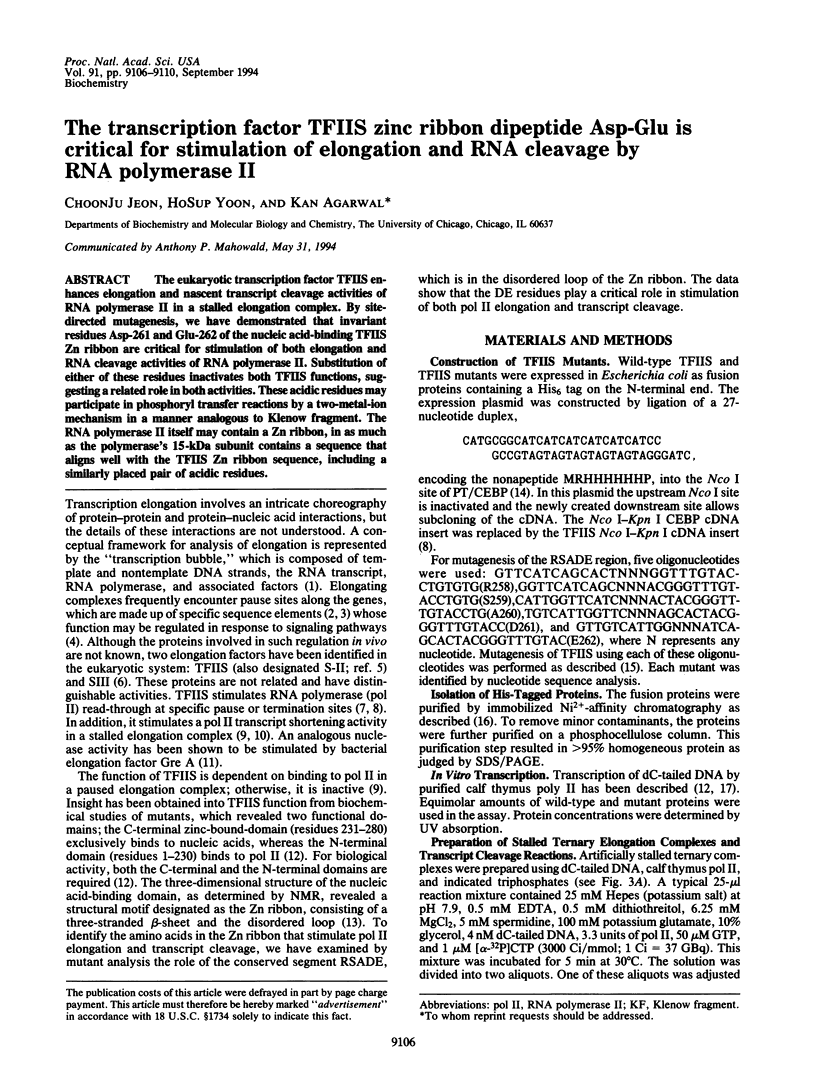
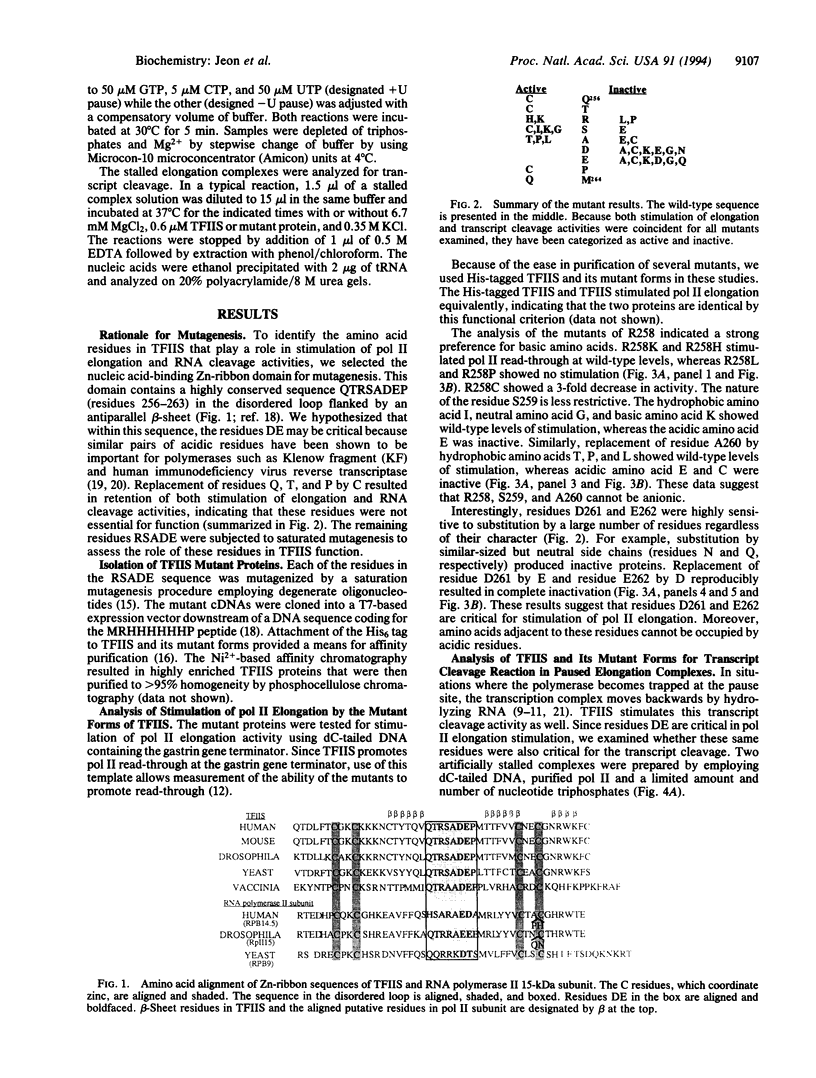
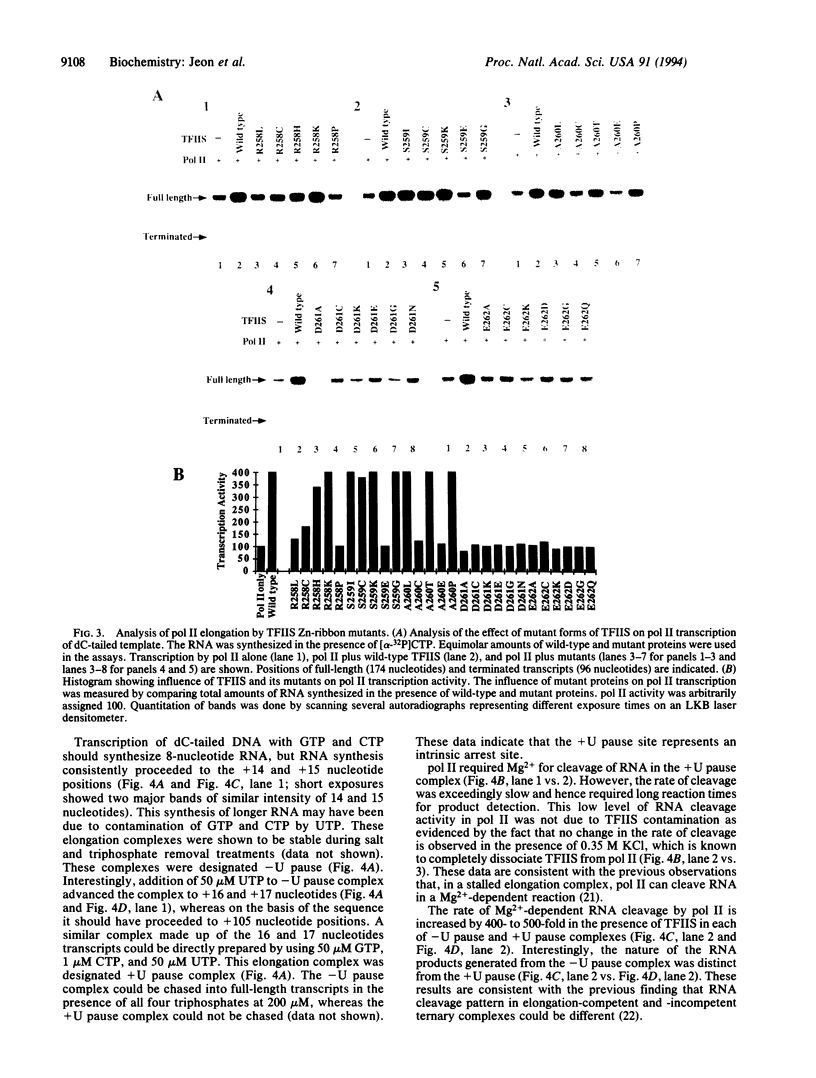
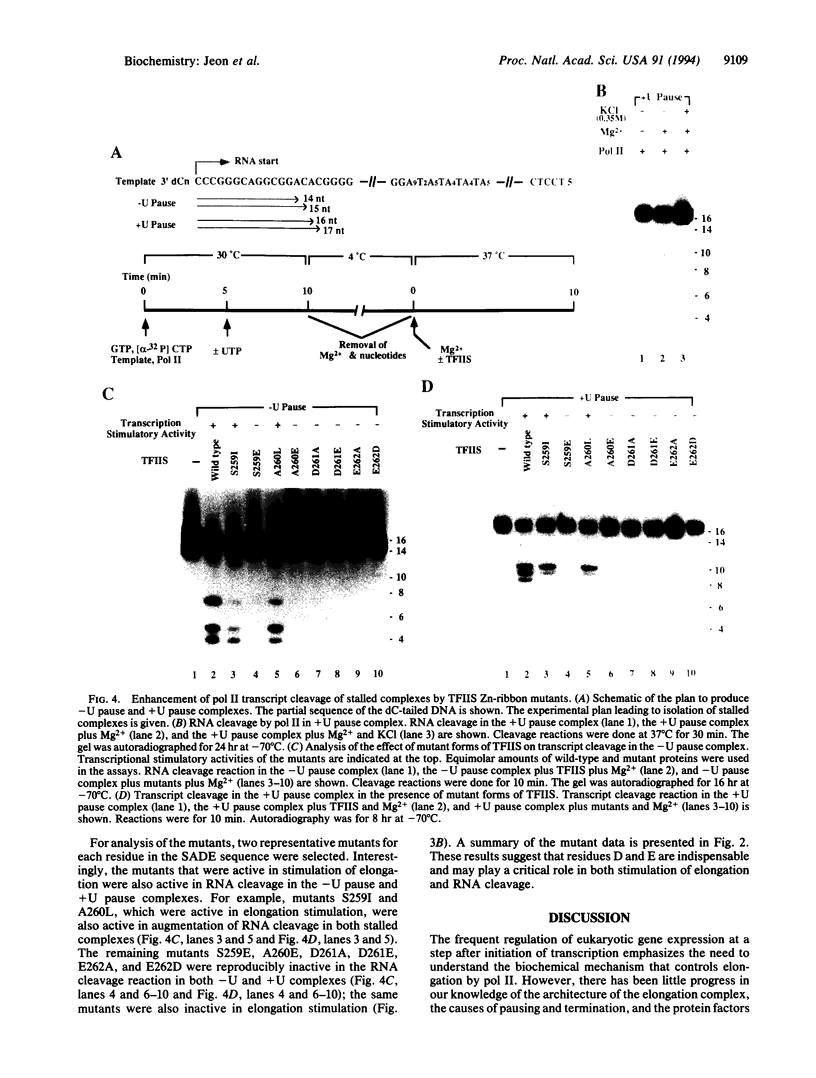
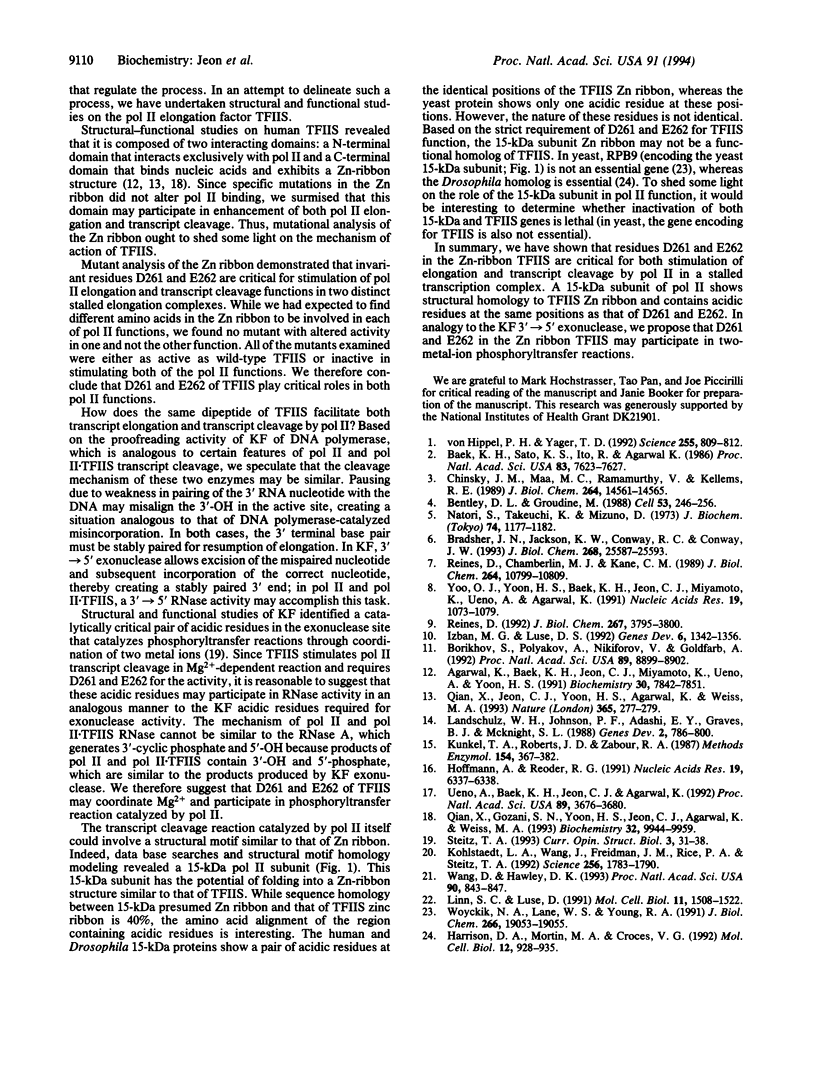
Images in this article
Selected References
These references are in PubMed. This may not be the complete list of references from this article.
- Agarwal K., Baek K. H., Jeon C. J., Miyamoto K., Ueno A., Yoon H. S. Stimulation of transcript elongation requires both the zinc finger and RNA polymerase II binding domains of human TFIIS. Biochemistry. 1991 Aug 6;30(31):7842–7851. doi: 10.1021/bi00245a026. [DOI] [PubMed] [Google Scholar]
- Baek K. H., Sato K., Ito R., Agarwal K. RNA polymerase II transcription terminates at a specific DNA sequence in a HeLa cell-free reaction. Proc Natl Acad Sci U S A. 1986 Oct;83(20):7623–7627. doi: 10.1073/pnas.83.20.7623. [DOI] [PMC free article] [PubMed] [Google Scholar]
- Bentley D. L., Groudine M. Sequence requirements for premature termination of transcription in the human c-myc gene. Cell. 1988 Apr 22;53(2):245–256. doi: 10.1016/0092-8674(88)90386-8. [DOI] [PubMed] [Google Scholar]
- Borukhov S., Polyakov A., Nikiforov V., Goldfarb A. GreA protein: a transcription elongation factor from Escherichia coli. Proc Natl Acad Sci U S A. 1992 Oct 1;89(19):8899–8902. doi: 10.1073/pnas.89.19.8899. [DOI] [PMC free article] [PubMed] [Google Scholar]
- Bradsher J. N., Jackson K. W., Conaway R. C., Conaway J. W. RNA polymerase II transcription factor SIII. I. Identification, purification, and properties. J Biol Chem. 1993 Dec 5;268(34):25587–25593. [PubMed] [Google Scholar]
- Chinsky J. M., Maa M. C., Ramamurthy V., Kellems R. E. Adenosine deaminase gene expression. Tissue-dependent regulation of transcriptional elongation. J Biol Chem. 1989 Aug 25;264(24):14561–14565. [PubMed] [Google Scholar]
- Harrison D. A., Mortin M. A., Corces V. G. The RNA polymerase II 15-kilodalton subunit is essential for viability in Drosophila melanogaster. Mol Cell Biol. 1992 Mar;12(3):928–935. doi: 10.1128/mcb.12.3.928. [DOI] [PMC free article] [PubMed] [Google Scholar]
- Hoffmann A., Roeder R. G. Purification of his-tagged proteins in non-denaturing conditions suggests a convenient method for protein interaction studies. Nucleic Acids Res. 1991 Nov 25;19(22):6337–6338. doi: 10.1093/nar/19.22.6337. [DOI] [PMC free article] [PubMed] [Google Scholar]
- Izban M. G., Luse D. S. The RNA polymerase II ternary complex cleaves the nascent transcript in a 3'----5' direction in the presence of elongation factor SII. Genes Dev. 1992 Jul;6(7):1342–1356. doi: 10.1101/gad.6.7.1342. [DOI] [PubMed] [Google Scholar]
- Kohlstaedt L. A., Wang J., Friedman J. M., Rice P. A., Steitz T. A. Crystal structure at 3.5 A resolution of HIV-1 reverse transcriptase complexed with an inhibitor. Science. 1992 Jun 26;256(5065):1783–1790. doi: 10.1126/science.1377403. [DOI] [PubMed] [Google Scholar]
- Kunkel T. A., Roberts J. D., Zakour R. A. Rapid and efficient site-specific mutagenesis without phenotypic selection. Methods Enzymol. 1987;154:367–382. doi: 10.1016/0076-6879(87)54085-x. [DOI] [PubMed] [Google Scholar]
- Landschulz W. H., Johnson P. F., Adashi E. Y., Graves B. J., McKnight S. L. Isolation of a recombinant copy of the gene encoding C/EBP. Genes Dev. 1988 Jul;2(7):786–800. doi: 10.1101/gad.2.7.786. [DOI] [PubMed] [Google Scholar]
- Linn S. C., Luse D. S. RNA polymerase II elongation complexes paused after the synthesis of 15- or 35-base transcripts have different structures. Mol Cell Biol. 1991 Mar;11(3):1508–1522. doi: 10.1128/mcb.11.3.1508. [DOI] [PMC free article] [PubMed] [Google Scholar]
- Natori S., Takeuchi K., Mizuno D. DNA-dependent RNA polymerase from Ehrlich ascites tumor cells. 3. Ribonuclease H and elongating activity of stimulatory factor S-II. J Biochem. 1973 Dec;74(6):1177–1182. doi: 10.1093/oxfordjournals.jbchem.a130345. [DOI] [PubMed] [Google Scholar]
- Qian X., Gozani S. N., Yoon H., Jeon C. J., Agarwal K., Weiss M. A. Novel zinc finger motif in the basal transcriptional machinery: three-dimensional NMR studies of the nucleic acid binding domain of transcriptional elongation factor TFIIS. Biochemistry. 1993 Sep 28;32(38):9944–9959. doi: 10.1021/bi00089a010. [DOI] [PubMed] [Google Scholar]
- Qian X., Jeon C., Yoon H., Agarwal K., Weiss M. A. Structure of a new nucleic-acid-binding motif in eukaryotic transcriptional elongation factor TFIIS. Nature. 1993 Sep 16;365(6443):277–279. doi: 10.1038/365277a0. [DOI] [PubMed] [Google Scholar]
- Reines D., Chamberlin M. J., Kane C. M. Transcription elongation factor SII (TFIIS) enables RNA polymerase II to elongate through a block to transcription in a human gene in vitro. J Biol Chem. 1989 Jun 25;264(18):10799–10809. [PubMed] [Google Scholar]
- Reines D. Elongation factor-dependent transcript shortening by template-engaged RNA polymerase II. J Biol Chem. 1992 Feb 25;267(6):3795–3800. [PMC free article] [PubMed] [Google Scholar]
- Ueno A., Baek K., Jeon C., Agarwal K. Netropsin specifically enhances RNA polymerase II termination at terminator sites in vitro. Proc Natl Acad Sci U S A. 1992 May 1;89(9):3676–3680. doi: 10.1073/pnas.89.9.3676. [DOI] [PMC free article] [PubMed] [Google Scholar]
- Wang D., Hawley D. K. Identification of a 3'-->5' exonuclease activity associated with human RNA polymerase II. Proc Natl Acad Sci U S A. 1993 Feb 1;90(3):843–847. doi: 10.1073/pnas.90.3.843. [DOI] [PMC free article] [PubMed] [Google Scholar]
- Woychik N. A., Lane W. S., Young R. A. Yeast RNA polymerase II subunit RPB9 is essential for growth at temperature extremes. J Biol Chem. 1991 Oct 5;266(28):19053–19055. [PubMed] [Google Scholar]
- Yoo O. J., Yoon H. S., Baek K. H., Jeon C. J., Miyamoto K., Ueno A., Agarwal K. Cloning, expression and characterization of the human transcription elongation factor, TFIIS. Nucleic Acids Res. 1991 Mar 11;19(5):1073–1079. doi: 10.1093/nar/19.5.1073. [DOI] [PMC free article] [PubMed] [Google Scholar]
- von Hippel P. H., Yager T. D. The elongation-termination decision in transcription. Science. 1992 Feb 14;255(5046):809–812. doi: 10.1126/science.1536005. [DOI] [PubMed] [Google Scholar]





